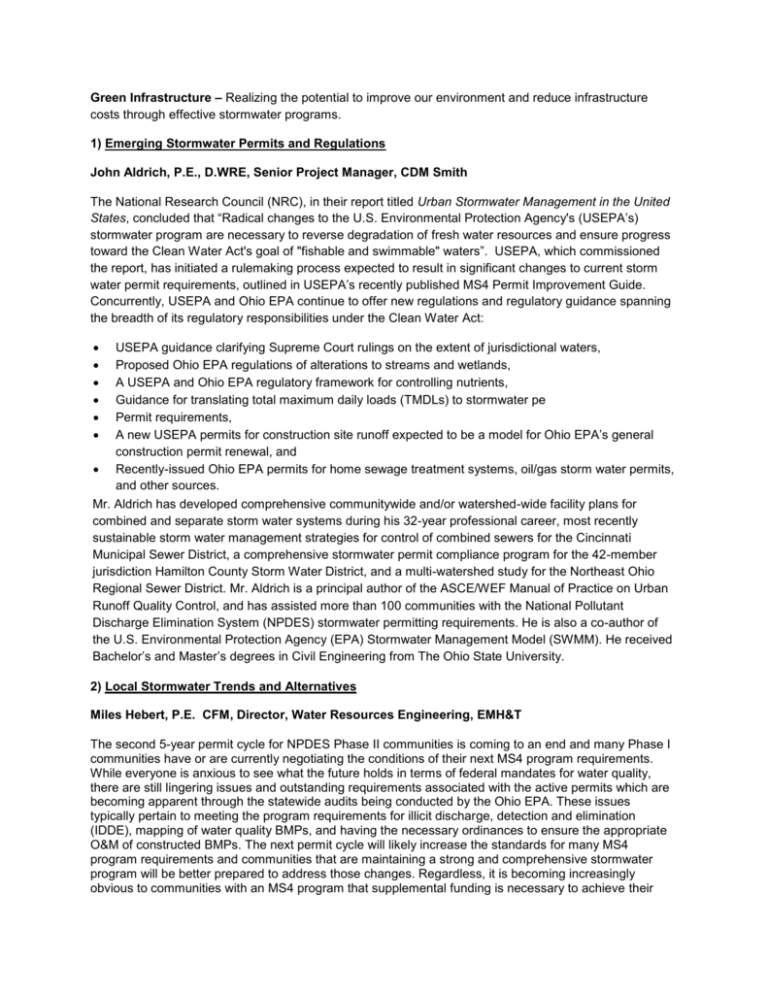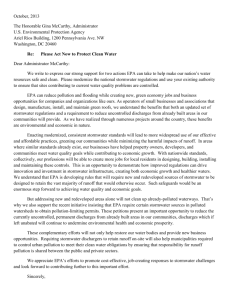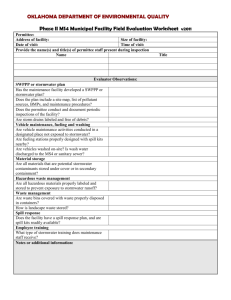green-infrastructure-epn-breakfast-speaker-abstracts
advertisement

Green Infrastructure – Realizing the potential to improve our environment and reduce infrastructure costs through effective stormwater programs. 1) Emerging Stormwater Permits and Regulations John Aldrich, P.E., D.WRE, Senior Project Manager, CDM Smith The National Research Council (NRC), in their report titled Urban Stormwater Management in the United States, concluded that “Radical changes to the U.S. Environmental Protection Agency's (USEPA’s) stormwater program are necessary to reverse degradation of fresh water resources and ensure progress toward the Clean Water Act's goal of "fishable and swimmable" waters”. USEPA, which commissioned the report, has initiated a rulemaking process expected to result in significant changes to current storm water permit requirements, outlined in USEPA’s recently published MS4 Permit Improvement Guide. Concurrently, USEPA and Ohio EPA continue to offer new regulations and regulatory guidance spanning the breadth of its regulatory responsibilities under the Clean Water Act: USEPA guidance clarifying Supreme Court rulings on the extent of jurisdictional waters, Proposed Ohio EPA regulations of alterations to streams and wetlands, A USEPA and Ohio EPA regulatory framework for controlling nutrients, Guidance for translating total maximum daily loads (TMDLs) to stormwater pe Permit requirements, A new USEPA permits for construction site runoff expected to be a model for Ohio EPA’s general construction permit renewal, and Recently-issued Ohio EPA permits for home sewage treatment systems, oil/gas storm water permits, and other sources. Mr. Aldrich has developed comprehensive communitywide and/or watershed-wide facility plans for combined and separate storm water systems during his 32-year professional career, most recently sustainable storm water management strategies for control of combined sewers for the Cincinnati Municipal Sewer District, a comprehensive stormwater permit compliance program for the 42-member jurisdiction Hamilton County Storm Water District, and a multi-watershed study for the Northeast Ohio Regional Sewer District. Mr. Aldrich is a principal author of the ASCE/WEF Manual of Practice on Urban Runoff Quality Control, and has assisted more than 100 communities with the National Pollutant Discharge Elimination System (NPDES) stormwater permitting requirements. He is also a co-author of the U.S. Environmental Protection Agency (EPA) Stormwater Management Model (SWMM). He received Bachelor’s and Master’s degrees in Civil Engineering from The Ohio State University. 2) Local Stormwater Trends and Alternatives Miles Hebert, P.E. CFM, Director, Water Resources Engineering, EMH&T The second 5-year permit cycle for NPDES Phase II communities is coming to an end and many Phase I communities have or are currently negotiating the conditions of their next MS4 program requirements. While everyone is anxious to see what the future holds in terms of federal mandates for water quality, there are still lingering issues and outstanding requirements associated with the active permits which are becoming apparent through the statewide audits being conducted by the Ohio EPA. These issues typically pertain to meeting the program requirements for illicit discharge, detection and elimination (IDDE), mapping of water quality BMPs, and having the necessary ordinances to ensure the appropriate O&M of constructed BMPs. The next permit cycle will likely increase the standards for many MS4 program requirements and communities that are maintaining a strong and comprehensive stormwater program will be better prepared to address those changes. Regardless, it is becoming increasingly obvious to communities with an MS4 program that supplemental funding is necessary to achieve their program objectives without unduly impacting their general funds. Stormwater utility fee programs have been in existence for more than two decades in communities both big and small, but are now being considered by more cities and counties who realize the demands of their expanding MS4 programs are beyond their current limited funding. The process of developing a utility program is an opportunity to gain a better understanding of the current and projected program needs, but also presents political challenges that can only be overcome through effective education of municipal staff, elected officials and the public at large. Recognizing a community’s storm system as a public utility is the first step in gaining broader recognition of the needs to both maintain and improve that system. Miles Hebert is the Director or Water Resources at EMH&T where he manages site specific and watershed scale stormwater management studies. Miles oversees staff in the preparation of preliminary and final engineering studies and construction drawings pertaining to stormwater best management practices, floodplain management and ecosystem restoration. Miles works with both private development and municipal clientele to ensure regulatory compliance with local, state and federal regulations. Miles is a 1988 graduate of The Ohio State University with a degree in Civil Engineering and is also a Certified Floodplain Manager as recognized by the Association of State Floodplain Managers. 3) Stormwater Innovations with Green Infrastructure Kari Mackenbach, CFM, National Practice Leader, Green Infrastructure, URS Corp. Green Infrastructure techniques are stormwater best management practices that can store and/or infiltrate runoff typically coming from an impervious area. The use of green infrastructure in urban watersheds can reduce the volume and rates of water flows through urban stream corridors during periods of peak wet weather flows and increase the base flow in these systems in drier summer months. One anticipated result of strategic placement of green infrastructure includes a reduction in the frequency, duration and magnitude of combined sewer overflow (CSO) events. Other results include an associated decrease in stream bank erosion, nutrient & sediment transport, loss of aquatic habitat, and minimization of flood magnitude and extent. Properly selected and sited in the sewershed, the appropriate combination of green infrastructure and traditional (gray) engineering solutions could improve the sustainability of urban watersheds by improving urban environmental quality while reducing costs to municipalities and embracing social values. Kari coordinates all efforts of the URS Green Infrastructure Practice across the United States. She is responsible for the overall quality of the practice related to work performed by the Green Infrastructure Practice Group. Kari is also responsible for the relationship forged with the U.S. EPA to study the impacts and benefits of green infrastructure in urban environments. This relationship, called a CRADA (Cooperative Research and Development Agreement) is the first of its kind. The purpose of the CRADA is to allow the U.S. EPA to participate and be vested in determining which green infrastructure techniques have the most impact and perform the best in urban environments. Kari is a 1993 graduate of The Ohio State University with a degree in Natural Resources, Policies and Planning and is also a certified Floodplain Manager as recognized by the Association of State Floodplain Managers.








